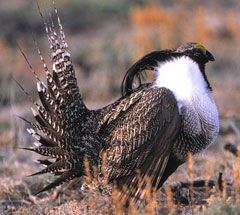 The feds have decided against listing a grouse sub-species that exists only in Nevada and California as a threatened or endangered species.
The feds have decided against listing a grouse sub-species that exists only in Nevada and California as a threatened or endangered species.
Can we get an amen from the choir?
We see this as a positive sign that Colorado and ten other western states might also escape certain Armageddon, when Interior Secretary Sally Jewell announces in September whether the greater sage grouse, which numbers closer to a half million will escape the listing disaster.
The AP says there are an estimated 2,500 to 9,000 bistate grouse in a 7,000 square area near the Yosemite National Park, and because of agreements with ranchers to conserve land, POOF! No more danger of extinction.
Jason Weller, chief of the U.S. Department of Agriculture’s Natural Resource and Conservation Service, said he believes the steps taken in Nevada and California should be used as a model to head off a potential listing of the greater sage grouse stretching across Washington, Oregon, Idaho, Utah, Wyoming, Montana, Colorado, North Dakota and South Dakota.
“Today’s decision is only for the bistate sage grouse, but it gives me great hope and optimism,” Weller said. “I hope folks take a hard look at this decision, the key ingredients and what we can learn from that and apply those to the greater sage grouse, because that’s what’s up next.”
Way to condescend, Mr. Weller.
Here’s the link to the Western Governors Association’s page of more reports than we have to time to count on all of the conservation efforts, habitat improvements, and hundreds of millions of dollars spent to help that bird population throughout the West.
Just in Colorado, more than $9 million has been spent since 2005 to support the grouse and more than 80,600 acres of habitat has been protected by Colorado Parks and Wildlife through fee title purchase or conservation easements, at a cost of more than $53 million.
In addition, the Colorado Cattlemen’s Agricultural Land Trust holds permanent conservation easements on more than 45,000 acres of sage-grouse habitat at a cost of $10 million and more than 125,000 acres of private land has been permanently conserved.
So with more than 250,600 acres in Colorado for 5,000 greater sage grouse (2012 count), that gives each bird about 50 damn acres to do what it pleases.
And $82 million seems like a lot of money to spend on several thousand birds in our tiny corner of the world, but a federal endangered or threatened listing will cost a lot more, says the Washington Post.
How costly? Compare it to the decision to include the Northern spotted owl on the endangered species list in 1990. That decision impacted 24 million acres of land across Washington, Oregon and California. Timber counties are still struggling to recover. The sage grouse lives on 165 million acres, covering land used by mining, energy, oil and gas and developers. Jewell’s announcement today will be a sign to 11 Western states that the grouse’s habitat isn’t lost.
We’ll take that sign – an enormous blinking neon sign, please — that says the West is still open for business.
